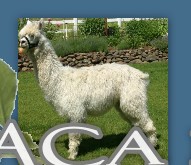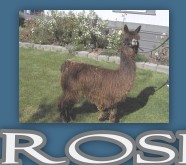|
Alpaca Info Library
What
is an Alpaca?
The
Alpaca (Vicugna pacos) is a
domesticated species of South American camelid
developed from the wild alpacas. It resembles a sheep in
appearance, but is larger and has a long erect neck as
well as coming in many colors, whereas sheep are
generally bred to be white.
Alpacas
are kept in herds that graze on the level heights of the
Andes of Ecuador, southern Peru, northern Bolivia, and
northern Chile at an altitude of 3500 to 5000 meters
above sea-level, throughout the year. Alpacas are
considerably smaller than llamas,
and unlike them are not used as beasts of burden but are
valued only for their fiber.
Alpacas only have fleece fibers, not woolen fibers, used
for making knitted and woven items much as sheep's wool
is. These items include: blankets, sweaters, hats,
gloves, scarves, a wide variety of textiles and ponchos
in South America, and sweaters, socks and coats in other
parts of the world. The fiber comes in more than 52
natural colors as classified in Peru, 12 as classified
in Australia and 22 as classified in America. Alpacas
and llamas differ in that llamas have banana shaped ears
and long tails and alpacas have straight ears and stubby
tails. Aside from these differences, llamas in general
are on average 1-2 feet taller, and bigger in proportion
than alpacas.
In
the textile industry, "alpaca" primarily
refers to the hair of Peruvian alpaca, but more broadly
it refers to a style of fabric originally made from
alpaca hair but now often made from similar fibers, such
as mohair, Icelandic sheep wool, or even high-quality
English wool. In trade, distinctions are made between
alpacas and the several styles of mohair and luster.
---------------------------------------------------------------------------------------------------------------------------------------

Business Planning
The Alpaca Business Planner
By Mike Safley
First and foremost, I think prospective alpaca breeders should realize that alpacas are a business, not an investment. Investments have traditionally been thought of as financial stocks, bonds, gold, silver, and real estate. All of these things can be owned passively, and when need be, you can sell them by calling your broker and asking him to liquidate the asset on your behalf.
Alpacas are a business opportunity. They need to be fed, cleaned up after, shorn, housed, and marketed before you can profit from them. And, you need to pay the bills before you can determine your profit. While I may be stating the obvious, this is an important concept to understand. There is no better tool to help make this clear than a business plan.
We have created this business planning tool to help you through all of the decisions that a prudent person would make prior to committing their hard-earned capital to start an alpaca business. First, it is important to choose your alpaca marketing niche and decide how much money that you would like to make. You will also need to make decisions about whether you are going to treat alpacas as a business or hobby, what business entity to use, the tax consequences of your investment, the initial start-up costs, ongoing expenses, and decisions about whether to pay cash or to buy your alpacas on terms.
If you would like input on all of these decisions, we recommend that you attend our seminar, "How to Buy Breed, and Succeed in the Alpaca Business". Once you have made these decisions, we have created the business planning calculator to assist you in creating a financial plan. You can fill out the forms that accompany this article by clicking "Proceed" under the Alpaca Business Planner heading on the right, and submit them to my associate, Fred Kraft. He will work with you to produce your personal version of the 10-year plan that you will find later in this text.
Choose Your Alpaca Market Niche
Alpacas came in two kinds, 85 colors, many quality levels, young, old, and are priced from inexpensive to expensive. There is a perfect alpaca for everyone no matter what their preference. This is both a delight and a dilemma.
One of the most critical decisions an aspiring alpaca breeder can make is what kind of alpacas to raise. The first choice that needs to be made is; will you breed
suris, huacayas, or both? If you breed both, you must realize that eventually you will need twice as many
herdsires. It also means that you will probably have a larger herd.
To understand the differences between suris and huacayas you may want to read,"The Ideal Alpaca: Suri and
Huacaya". Both breeds tend to cost, on average, about the same price. The main difference is the type of fleece they display. In any case, choosing which breed to buy is often a threshold decision. I recommend you buy what stirs your emotions.
Beyond the breed you decide on, you should consider what colors you want to breed, whether you want to breed show stock, pets, or production females. All these categories have a price point.
The lower the average price of your alpacas, the larger the market will be. As my dad used to say, "God made more poor people than he did rich ones." The key issue to consider on price is your ability to sell the females' cria that you produce for the same price that you paid for the mother.
If you follow the selection advice and genetic improvement suggestions found in my book, "Alpacas: Synthesis of a Miracle", you can easily learn how to produce superior stock for whichever market niche you choose. I also recommend you consider joining the online alpaca community
www.IdealAlpaca.com.
In any case, you should think carefully about what type and price of alpaca you want to raise because this decision will impact your budget and your marketing approach. These decisions are every bit as important as how many alpacas to buy and what barn to build.
(Please note that this text is a only small excerpt of Mike's article about alpaca business planning. The full article is available as a PDF document at the top of this page.)

|























